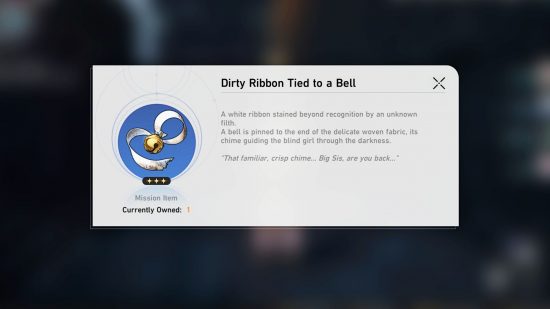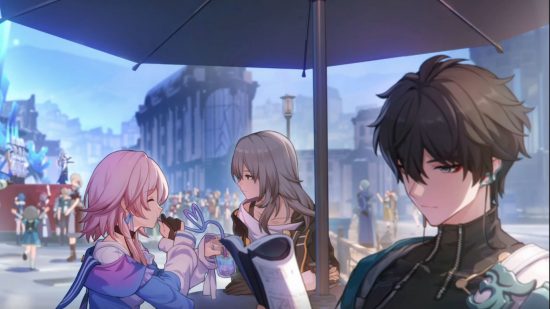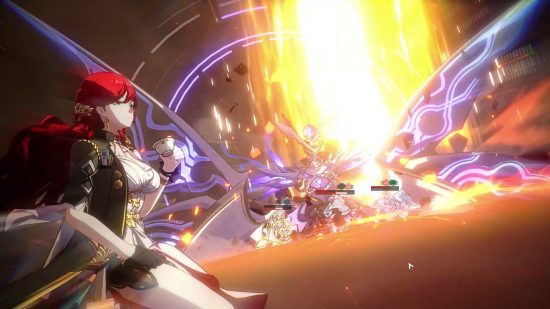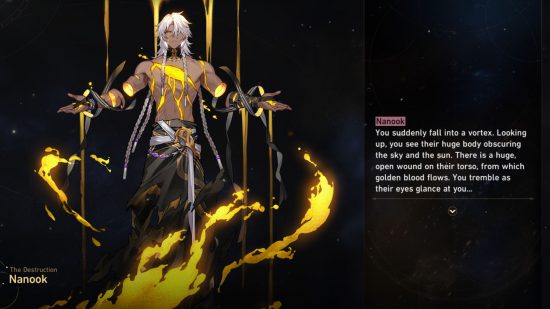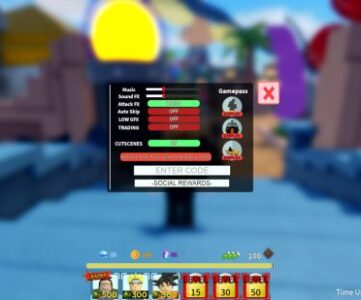[ad_1]
Our Verdict
Honkai Star Rail is a highly polished turn-based RPG that builds off the Hoyoverse gacha machine, and while it certainly doesn’t reinvent the wheel, its colourful cast of characters and mercurial tone sets it on the right track.
Before our Honkai Star Rail review leaves the station, let’s first address the slot machine in the room. Honkai Star Rail is a gacha game, and as such it comes with an awful lot of psychological baggage. All the trappings of the Hoyoverse monetisation machine are here: character banners, battle passes, subscriptions, and of course, an in-game shop bursting with premium currency. Each one comes with a real-world price tag, and many of the RPG game’s reward systems naturally lead back to these menus.

Like any gambling machine worth its salt, Honkai Star Rail inundates me with free currency in its opening hours in an effort to get me hooked on the dopamine rush of pulling a virtual slot machine – but even with Honkai Star Rail codes, the chances of actually acquiring those coveted five-star characters are cripplingly low. No matter how much enjoyment you might glean from it, Star Rail is still intentionally designed to cajole you into handing over your money, and that makes it difficult to recommend. If you struggle with impulse control, I implore you to turn back now.
All that said, if you find you can resist the pull of its insidious monetisation, there is plenty of enjoyment to be found here. Honkai Star Rail’s story is undeniably compelling, featuring remote gods, cancerous world eaters, a legion of antimatter monsters, and of course, an interstellar locomotive at the heart of it all. Star Rail is the fourth instalment in the Honkai series, though you’ll be forgiven if this is your first brush with Genshin Impact’s sci-fi counterpart. Its predecessor, Honkai Impact 3rd, garnered a decent amount of popularity upon release, but its fanbase was immediately eclipsed by the arrival of Hoyoverse’s aforementioned cultural juggernaut two years later.
Thankfully, while Honkai’s lore contains both multitudes and multiverses, Hoyoverse makes an effort to lower the barrier to entry for series newcomers by positioning Star Rail as a spiritual sequel rather than a direct one. There are no arduous exposition dumps or recaps to muddle through in those first few hours. Instead, I’m thrown right into the thick of a terrorist attack on an outer-space research station and left to piece everything together using context clues. Of course, it certainly helps that I’m dropped into the clueless shoes of an amnesiac, summoned into being under suspicious circumstances and armed with little more than a baseball bat.
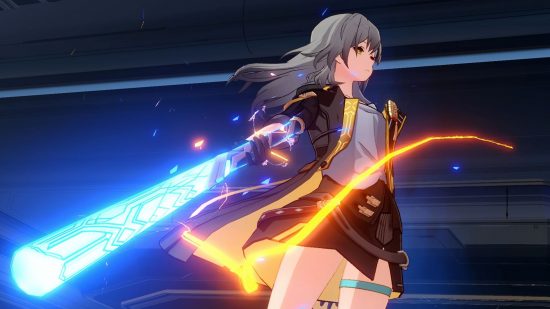
Honkai’s Trailblazer makes for a great audience surrogate, but they’re also a certifiably weird little guy. Whether masculine or feminine, they have an affinity for rummaging through trash cans and put an endless supply of idiosyncratic dialogue options at my disposal as I play through this adventure. This degree of individuality is a far cry from Genshin Impact’s Traveler, who generally responds to situations with a vacant smile at Paimon, their ever-present mouthpiece. While the Trailblazer is hardly a chatterbox, the absence of Paimon in Star Rail is noticeable for all the right reasons and keeps instances of repetitive, often patronising back-and-forth dialogue to a minimum.
It’s worth mentioning that, in real terms, Star Rail’s story developments typically take the form of extended, static sequences in which our ragtag band of heroes stand around and recite dialogue at one another. These are the points at which Star Rail is most likely to lose its audience – if you’re not fully invested, then it’s a lot of waiting around for conversations to end. I found myself skipping dialogue during specific missions, while the voice performances in others left me on the edge of my seat.
Honkai Star Rail’s tendency towards absurdism certainly helps mitigate any monotony, often occurring when you least expect it. In one instance, I climbed inside a hotel closet, experienced what can best be described as a minor psychotic episode à la Disco Elysium, and ambushed room service. In another, a potted plant sensuously begged me to water it. It’s also shockingly self-aware, with plenty of throwaway lines that poke fun at the gacha model itself. References to all forms of media are scattered throughout, often appearing as items, NPCs, and even achievements. Whether it be Bloodborne, Rick Astley, Citizen Kane, or even Shakespeare, you never know when the next easter egg will be thrown at you. All of these idiosyncrasies congeal into ironic existentialism, delivered with a wink here and a nudge there.
What’s more, I found myself pleasantly won over by Honkai Star Rail’s dramatis personae. From March 7th’s effusive optimism to Dan Heng’s quiet introversion, each character is an obvious archetype, but there’s a familiarity to them that harks back to ’90s JRPGs. Unlike Genshin, I find myself more invested in the characters themselves than I am in pulling them from banners. Perhaps most impressively of all, Star Rail made me care about the truly minor characters: NPCs with bland names, who you might dismiss as part of the scenery until they unwittingly end up at the centre of a conspiracy or two.
Honkai Star Rail makes another bid to escape the shadow of Genshin Impact by adopting a turn-based combat system. Of course, there’s no shortage of turn-based RPGs out there, and the likes of Final Fantasy and Persona have long since proven that this format can remain persistently fun across countless hours of playtime. While Star Rail’s combat doesn’t quite plumb the titanic depths of either series, it makes up for it by being both lightweight and remarkably fast-paced. Honkai Star Rail characters are limited to three abilities, and there are no bloated item menus to trawl through, resulting in snappy turns that are over in seconds. It’s also possible to toggle double-speed and auto-battle at any point during combat, which is invaluable if you’re short on time or as impatient as I am.
The crux of Star Rail’s combat complexity hinges on a toughness and weakness break mechanic, in which certain enemies are susceptible to certain elemental types. It’s a tried-and-true concept that encourages you to switch up your team every once in a while, but there may not be enough complexity here to sustain hardcore turn-based fans. Honkai Star Rail is inarguably catered to a casual audience, and enemies utilise attack patterns and abilities that are standard fare for the genre. However, this also makes it fiendishly easy to pick up and put down at will, and farming for materials rarely feels like a true grind. It also helps that character animations are both dynamic and dripping in personality – watching the hyper-feminine Himeko elegantly sip from a teacup while calling in a drone strike really never gets old.
What depth Star Rail’s enemy design may lack, character customisation makes up for in spades. Between light cones and relics, planar ornaments and eidolons, if you’re fond of outfitting and refining characters to make numbers go up, you won’t be disappointed. However, progression is often hindered by the luck of the draw – or lack thereof. You can only farm so many upgrade materials per day, and equipment is either redeemed from banners or obtained as randomly generated rewards. Getting the wrong ones can often be a source of frustration, especially if you have a certain character you’d love to use but can’t kit out effectively. To really have a good time with Star Rail, you have to be prepared to roll with the punches of chance, and work with what you have rather than pine for what you don’t.
Star Rail’s gameplay loop mirrors Genshin, with a routine of daily missions and combat challenges that provide a break from the endless procession of quests making up its campaign. Let’s be honest, no one really likes dailies; Hoyoverse clearly understands that too, since most of the objectives can be completed as you play, and optional side missions are often themselves segments of an ongoing questline. Standing head and shoulders above the rest is the Simulated Universe, a self-contained roguelike dungeon that tasks you with progressing through various stages of combat encounters and random events, culminating in a final boss. Clearing a run of the Simulated Universe makes for an excellent change of pace, and gifts Honkai Star Rail with longevity between content updates.
All these modes and missions can extend your play session, but Star Rail remains broadly respectful of your time with a fast-travel system that allows you to get to where you want to go immediately. Locations are segmented into an ever-expanding collection of small, self-contained maps that you regularly revisit over the course of the story, which makes it far easier to consume in bite-sized, manageable chunks. Sadly, this also means that we don’t get to experience the breathtaking, sprawling vistas previously seen in Genshin Impact. The frostbitten, divided world of Jarilo VII stands in sharp contrast to the retro-futuristic starskiff Xianzhou Luofu, but while the locales themselves have a strong sense of identity at the macro level, individual areas can often feel nondescript.

All in all, Honkai Star Rail’s campaign succeeds at pulling off some pretty deft tone shifts that constantly keep you on your toes. A streak of nihilism courses through its narrative, and even the best course of action is often limned in tragedy. While it can never truly escape the predacious nature of its gacha system, the lessons Hoyoverse has learned in the development of Genshin Impact bestow Honkai Star Rail with an exceptional quality of life that promises a bright and shining future.
[ad_1]

